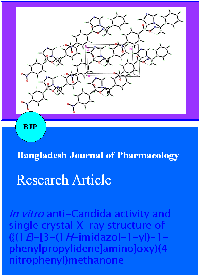In vitro anti-Candida activity and single crystal X-ray structure of ({(1E)-[3-(1H-imidazol-1-yl)-1-phenylpropylidene]amino}oxy)(4-nitrophenyl)methanone
DOI:
https://doi.org/10.3329/bjp.v9i1.16990Keywords:
Anti-Candida, Azoles, X-rayAbstract
Synthesis, characterization, and anti-Candida activity of ({(E)-[3-(1H-imidazol-1-yl)-1-phenylpropylidene]amino}oxy)(4-nitrophenyl)methanone (4) are reported. Compound 4 showed anti-Candida albicans activity (MIC = 0.6862 µmol/mL) being nearly 5-fold more potent than the gold standard antifungal drug, fluconazole (MIC ˃ 3.265 µmol/mL), on the clinical isolates of Candida albicans. Single crystal X-ray structure of the title compound 4 confirmed its assigned (E)-configuration. The compound crystallizes in the triclinic, P-1 (no. 2), a = 6.4633 (1) Å, b = 11.1063 (2) Å, c = 12.9872 (2) Å, α = 67.650 (1)°, β = 86.415 (1)°, γ = 86.776 (1)°, V = 860.01 (3)Å3, Z = 2, R(F) = 0.046, wR(F2) = 0.139, T = 296 K. The crystal structure is stabilized by weak intermolecular C—H•••O hydrogen interactions.
Downloads
326
217 Read
23
References
Aboul-Enein MN, El-Azzouny AA, Attia MI, Saleh OA, Kansoh AL. Synthesis and anti-Candida potential of certain novel 1-[(3-substituted-3-phenyl)propyl]-1H-imidazoles. Arch Pharm. 2011; 344: 794-801.
Attia MI, Zakaria AS, Almutairi MS, Ghoneim SW. In vitro anti-Candida activity of certain new 3-(1H-imidazol-1-yl)propan-1-one oxime esters. Molecules 2013; 18: 12208-21.
Brucker. APEX2, SAINT and SADABS. Brucker AXS Inc., Madison, Wisconsin, USA, 2009.
Canuto MM, Rodero FG. Antifungal drug resistance to azoles and polyenes. Lancet Infect Dis. 2002; 2: 550-63.
Clinical and Laboratory Standards Institute (CLSI). Reference method for broth dilution antifungal susceptibility testing of yeasts, approved standard M27-A2. 2nd ed. CLSI Document. Clinical and Laboratory Standards Institute, Villanova, PA, 2002, p 22.
Clinical and Laboratory Standards Institute (CLSI). Performance standards for antimicrobial disk susceptibility tests, approved standard. M2-A8. 8th ed. CLSI, Wayne, PA, 2005.
Ghannoum MA, Rice LB. Antifungal agents: Mode of action, mechanisms of resistance, and correlation of these mechanisms with bacterial resistance. Clin Microbiol Rev. 1999; 12: 501-17.
Groll AH, Walsh TJ. Uncommon opportunistic fungi: New nosocomial threats. Clin Microbiol Infect. 2001; 7, S2: 8-24.
Hossain MA, Ghannoum MA. New investigational antifungal agents for treating invasive fungal infections. Expert Opin Investig Drugs 2000; 9: 1797-1813.
Kathiravan MK, Salake AB, Chothe AS, Dudhe PB, Watode RP, Mukta MS, Gadhwe S. The biology and chemistry of antifungal agents: A review. Bioorg Med Chem. 2012; 19: 5678-98.
Lamb DC, Kelly BC, Baldwin BC, Kelly SL. Differential inhibition of human CYP3A4 and Candida albicans CYP51 with azole antifungal agents. Chem Biol Interact. 2000; 125: 165-75.
Moellering RC. Discovering new antimicrobial agents.Int J Antimicrob Agents. 2011; 37: 2-9.
Pfaller MA, Andes D, Diekema DJ, Espinel-Ingroff A, Sheehan D. Wild-type MIC distributions, epidemiological cutoff values and species-specific clinical breakpoints for fluconazole and Candida: Time for harmonization of CLSI and EUCAST broth microdilution methods. Drug Resist Updat. 2010; 13: 6180-95.
Pfaller MA, Diekema DJ. Epidemiology of invasive candidiasis: A persistent public health problem. Clin Microbiol Rev. 2007; 20: 133-63.
Roman G, Mares M, Nastasa V. A novel antifungal agent with broad spectrum: 1-(4-Biphenylyl)-3-(1H-imidazol-1-yl)-1-pro-panone. Arch Pharm. 2013; 346: 110-18.
Rossello A, Bertini S, Lapucci A, Macchia M, Martinelli A, Rapposelli S, Herreros E, Macchia B. Synthesis, antifungal activity, and molecular modeling studies of new inverted oxime ethers of oxiconazole. J Med Chem. 2002; 45: 4903-12.
Sheldrick GM. A short history of SHELX. Acta Crystallogr A. 2008; 64: 112-22.
Singh N. Changing spectrum of invasive candidiasis and its therapeutic implications. Clin Microbiol Infect. 2001; 7, S2: 1-7.
Slavin MA. Australian Mycology Interest Group. The epidemiology of candidaemia and mould infections in Australia. J Antimicrob Chemother. 2002; 49, S1: 3-6.
Sun QV, Xu JM, Cao YB, Zhang WN, Wu QY, Zhang DZ, Zhang J, Zhao HQ, Jiang YY. Synthesis of novel triazole derivatives as inhibitors of cytochrome P450 14α-demethylase (CYP51). Eur J Med Chem. 2007; 42: 1226-33.

Published
How to Cite
Issue
Section
License
Authors who publish with this journal agree to the following terms:
- Authors retain copyright and grant the journal right of first publication with the work simultaneously licensed under a Creative Commons Attribution License that allows others to share the work with an acknowledgement of the work's authorship and initial publication in this journal.
- Authors are able to enter into separate, additional contractual arrangements for the non-exclusive distribution of the journal's published version of the work (e.g., post it to an institutional repository or publish it in a book), with an acknowledgement of its initial publication in this journal.
- Authors are permitted and encouraged to post their work online (e.g., in institutional repositories or on their website) prior to and during the submission process, as it can lead to productive exchanges, as well as earlier and greater citation of published work (See The Effect of Open Access).
